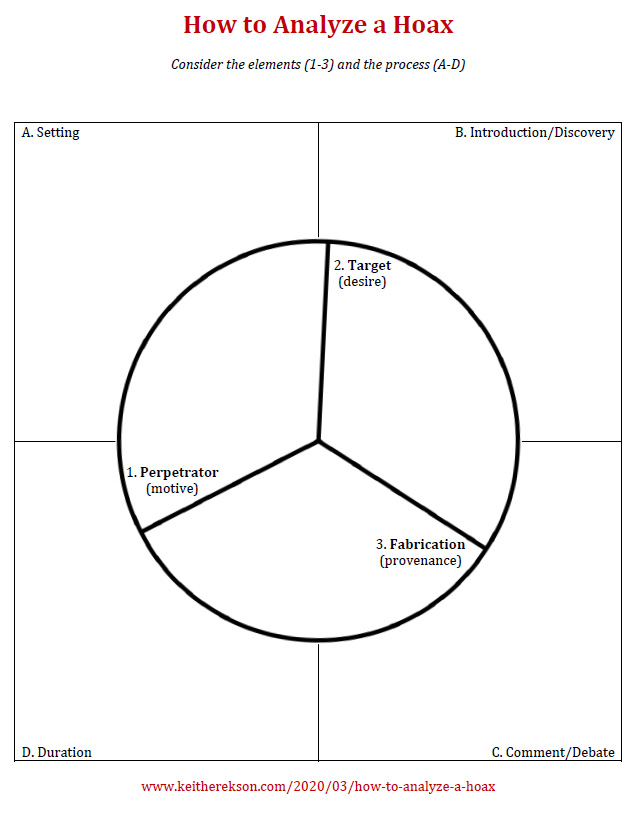How to Analyze a Hoax
Hoaxes come in all shapes and sizes, but they employ the same basic elements—a perpetrator (with a motive), a target constituency (with an unmet desire), and a fabrication (with a provenance). Hoaxes also follow a common lifecycle—they play off their setting, are introduced or “discovered,” grow through comment and debate, and then endure or fade away.

The Elements
1. The Perpetrator. Perpetrators of hoaxes frequently possess charisma, attention to detail, and commitment to their cause. They may be motivated by fame, money, or power. They may want to show off, draw attention, push an agenda, exact revenge, or just “mess around.” Some may be sociopaths who are both anti-social and without conscience. My students added another motive to the list—to become savvy citizens in the 21st century.
2. The Target Constituency. Victims of hoaxes often possess reasons for not disbelieving—they are proud, indifferent, ignorant, or superstitious. If you think you can’t be conned, then you’re just the person a con artist wants to meet! Deep down, sometimes not even fully known to themselves, targets also possess an unmet desire that encourages them to believe—vanity, pride, or validation; personal prejudices or chauvinism; longing for financial gain, entertainment, or vicarious thrills. Even the inventor of Sherlock Holmes, the author Sir Arthur Conan Doyle, was tricked by photographs of fairies.
3. A Fabrication. Every hoax must fabricate something—an artifact or item, an entity or person, facts or information. We call the fabrication a forgery if the perpetrator manufactured the entire new work. We call it a fake if an authentic object is altered, with the addition of a forged signature or something like that. But neither a forgery or a fake can simply spring out of nowhere, so the most important part of a fabrication is its provenance, or the story of where it came from and how it arrived on the scene today.
Con artist-turned-reality-TV-star R. Paul Wilson asserts that the formula for tricking any person is simple. X + Y = Z. People will believe any lie (Y) so long as it relates to a fact (X) and leads to a deep desire (Z). For example, it is true that eating healthy matters (X), so I can sell you an unproven “dietary supplement” (Y) if you desire easy results guaranteed (Z)!
The Process
A. Setting. Hoaxes play of their time and place. They are more common:
- in times of stress and upheaval (less common in times of stability),
- when there are clear divisions between us/them (less common with unity),
- when migration is restricted (less common with easier flow),
- when cultural authority wanes (less common when church and state align),
- during periods of scientific and technological change (less common when consensus).
B. Introduction/Discovery. After a perpetrator has manufactured a fabrication and courted a target constituency, the hoax begins when a “discovery” of the fabrication. In time its invented provenance comes out.
C. Comment and Debate. The “best” hoaxes are not too perfect or complete but have wiggle room to grow in public comment and debate. The debate galvanizes supporters and detractors as people take sides. Additional “supporting” evidence can be added to the conversation. Participants become invested as they contribute to the dialogue. Often an “unsuspecting champion” emerges who is also a target/victim of the perpetrator and has good credentials within the target community.
D. Duration/Longevity. Some hoaxes garner brief attention and then disappear quickly. Others endure to become persistent parts of the community or culture.
Putting the Pieces Together
Here’s a look at how the elements and process came together with the Elvis Presley Book of Mormon forgery.
1. Perpetrator (with a motive)
Unknown
2. Target Constituency (with an unmet desire)
Latter-day Saints who desired
- A story of individual change and redemption (Elvis from sinner to saint)
- A story of collective redemption and legitimacy (validation from a celebrity)
- An “inspiring” story to tell (to “promote faith”)
3. Fabrication (with provenance)
A copy of the Book of Mormon with forged annotations purportedly made by Elvis Presley (that surfaced through an Elvis fan who joined the Church in 1976)
A. Setting
- Late 1980s
- Elvis Presley and his parents have died (no one to contradict the story)
- Not a lot of Elvis memorabilia on the market yet (hard to verify)
B. Introduction/Discovery
- Attempt 1: Fan tries to sell book to a dealer who declines
- Attempt 2: Fan tells Osmond family that Elvis wanted them to have the book
C. Comment and Debate
- Osmond family becomes first victim/unsuspecting champion
- Book donated to the Church in 1989
- Accepted with little scrutiny by archivists or journalists
D. Duration
- Widely reported by speakers, writers, journalists for 30 years
- Inspired a movie in 2007
- Analysis of context and handwriting reveals forgery in 2018
You Try It
- One of the new corona virus hoaxes
- A recent hoax from 2018
- Something from the Museum of Hoaxes


[…] How to analyze a hoax […]
[…] How to Analyze a Hoax […]